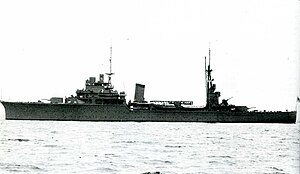Japanese cruiser Kashii

Kashii on 15 July 1941, at Yokohama during commissioning
|
|
| History | |
|---|---|
|
|
|
| Name: | Kashii |
| Ordered: | 1939 Fiscal Year |
| Laid down: | 4 October 1939 |
| Launched: | 15 October 1940 |
| Commissioned: | 15 July 1941 |
| Struck: | 20 March 1945 |
| Fate: |
|
| General characteristics | |
| Class and type: | Katori-class cruiser |
| Displacement: |
|
| Length: | 129.77 m (425 ft 9 in) |
| Beam: | 15.95 m (52 ft 4 in) |
| Draught: | 5.75 m (18 ft 10 in) |
| Propulsion: |
|
| Speed: | 18 knots (21 mph; 33 km/h) |
| Range: | 9,000 nautical miles (17,000 km) at 10 knots (19 km/h) |
| Complement: | 315 + 275 midshipmen |
| Armament: |
|
| Aircraft carried: | 1 × floatplane |
| Aviation facilities: | 1 catapult |
Kashii (香椎 練習巡洋艦 Kashii renshūjunyōkan?) was the third and final vessel completed of the three light cruisers in the Katori class, which served with the Imperial Japanese Navy (IJN) during World War II. The ship was named after a noted Shinto shrine in Fukuoka, Japan.
The Katori-class cruisers were originally ordered to serve as training ships in the 1937 and 1939 Supplementary Naval Budget. With the Pacific War, they were used as administrative flagships for various fleets, such as submarine command and control and to command escort squadrons. The ships were upgraded as the war progressed with additional anti-aircraft guns and depth charges.
Kashii was completed by Mitsubishi shipyards in Yokohama on 15 July 1941, and was initially assigned to Sasebo Naval Base.
With the growing tensions in the Pacific, Kashii was subsequently (31 July 1941) assigned to the Southern Expeditionary Fleet under Vice Admiral Jisaburo Ozawa. On 18 October 1941, Kashii became flagship of the Southern Expeditionary Fleet based out of Saigon, French Indochina. One month later, Kashii was transferred to Hainan and Vice Admiral Ozawa transferred his flag to the cruiser Chōkai.
...
Wikipedia
